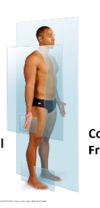Introduction to Body Cavities Flashcards
what plane is this?

sagittal
what plane is this?

transverse
what is the name of this plane?

coronal plane
how do u look at an axial CT or MRI?
is if standing by bedside at feet

SO: Left hand site of CT = right hand side of patient
what is the cranial cavity continious with?
cranial cavity continues into vertebral canal

which subcavities are found in the thoracic region?
thoracic cavity:
- pleural cavity (lungs)
- mediastinum (heart, esophagus, trachea, thoracic nerves and systemic blood vessels)
- pericardial cavity (inside the mediastinum) (heart)

what surrounds and protects the brain (inside the skull) - where do they go?
3 membranous layers: meninges - continue down vertebral column:
- dura mater (outer layer)
- arachnoid mater (middle layer - spider leg layer)
- pia meter (closest to brain - follows the contours of the brain and spinal cord

what is found betwen the arachnoid and pia meter layers
role of ^?
sub arachnoid space: filled with cerbrospinal fluid
- role: buffers and protects the brain and spinal scord
label this correctly


what is meningitis?
how test?
inflammation of the meninges
test: test CSF via lumbar puncture
what are serous membranes?
serous membranes: sealed, two layered internal cavities of the body. filled with serous fluid:
2 layers are continous:
a) partietal: line body cavity and share nerve supply to body wall: somatic
b) visceral: cover the organ and share same NS to organ: autonomic
which are the main three serous membranes?
- pleural cavity: serous membranes of lung
- pericardium: serous membrane o fheart
- peritoneum: serous membrane of (continuous membrane which lines the abdominal cavity and covers the abdominal organs)
how many pleural cavities are there?
whats in the mediastinum?
whats the pericardium
- 2 - 2 lungs lol
- mediastinum: where following are collected: heart, great vessels, trachea, oesophagus etc
- peridcardium: a thin sac that surrounds your heart.

what is inbetween the viesceral and parietal pleura?
function of ^?
- pleural fluid
-
function:
- reduces friction of expansion / depression
- help stick viseral pleura to parietal pleura























